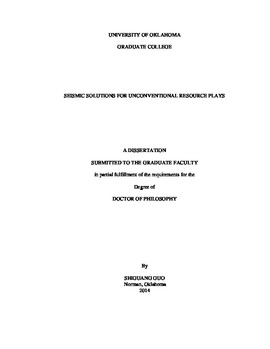| dc.description.abstract | Unconventional reservoir plays an increasingly important role for hydrocarbon exploration. Every reservoir has its unique properties, but it is mostly characterized by low permeability, such that hydraulic fracturing is required to provide pathways for fluid flow. Natural fractures can also provide important permeability. Unfortunately, seismic noise, aliasing, and footprint all contaminate fracture images. My dissertation is divided into four parts, which has been submitted for peer review publication: (1) image of Mississippian Limestone using preconditioned least-squares migration, (2) increasing image quality by developing migration driven 5D interpolation, (3) prediction of natural and induced fractures by correlation between curvature and AVAz vector, (4) evaluation of AVAz anisotropy and curvature in a post hydraulically fracturing Barnett Shale survey.
Conventional Kirchhoff migration often presents artifacts such as aliasing and acquisition footprint noise. I use least-squares migration to minimize the difference between the original data and the modeled demigrated data using an iterative conjugate gradient scheme. I apply this algorithm to image two Mississippian Limestone surveys. I apply the new preconditioned least-squares migration to a survey acquired over a new resource play in the Mid-Continent, USA. Acquisition footprint in shallow targets is attenuated and the signal-to-noise ratio is enhanced. To demonstrate the impact on interpretation, I generate a suite of seismic attributes to image the Mississippian limestone, and show that karst-enhanced fractures in the Mississippian limestone can be better illuminated.
Prestack Kirchhoff time migration is still the most popular migration algorithm due to its high efficiency and flexibility. Unfortunately suboptimal surface seismic acquisition often gives rise to both data and migration operator aliasing, both of which hinder subsequent interpretation. Current 5D interpolation techniques are applied in the surface data domain, typically on NMO-corrected CMP gathers. Such corrections properly flatten specular reflections for subsequent lateral interpolation but will not flatten unfocussed diffractions whose moveout is non-hyperblic on CMP gathers. I believe this shortcoming leads to the decrease in lateral resolution on (now largely artifact free) 5D interpolated seismic volumes. I have implemented an alternative migration driven 5D interpolation as my interpolation operator. I show that this approach will interpolate not only specular but nonspecular events.
The Barnett Shale is a major hydrocarbon resource play in the Fort Worth basin, it has been produced by drilling and completing horizontal wells perpendicular to the direction of maximum stress. I migrate the surface seismic data into a suite of azimuthal and offset bins, then calculate the AVO gradient from azimuthally-limited prestack gathers for each azimuth bin. By comparing the azimuthal AVO gradient variation, I generate an AVAz volume that can then be used to predict the orientation of horizontal stress. While natural fractures in the Barnett shale are almost all cemented, in other basins AVAz can be used to predict the orientation and intensity of natural fractures. Strike-slip faults are known to modify the subsurface stress regime. I map faults using both the strike and magnitude of the most-positive and most-negative principal curvatures and visually correlate them to AVAz. To be quantitative, I generate a vector correlation between AVAz and the two curvatures and find correlation between the “stress field” and the strike and intensity of structural deformation. By comparing two adjacent Barnett Shale seismic surveys—the first acquired before hydraulic fracturing and the second acquired after hydraulic fracturing find that in the survey acquired prior to hydraulic fracturing that AVAz anomalies are both stronger and highly correlated to major structural lineaments measured by curvature. In contrast, AVAz anomalies in the acquired after hydraulic fracturing are weaker and compartmentalized by rather than correlated to most-positive curvature lineaments. | en_US |
